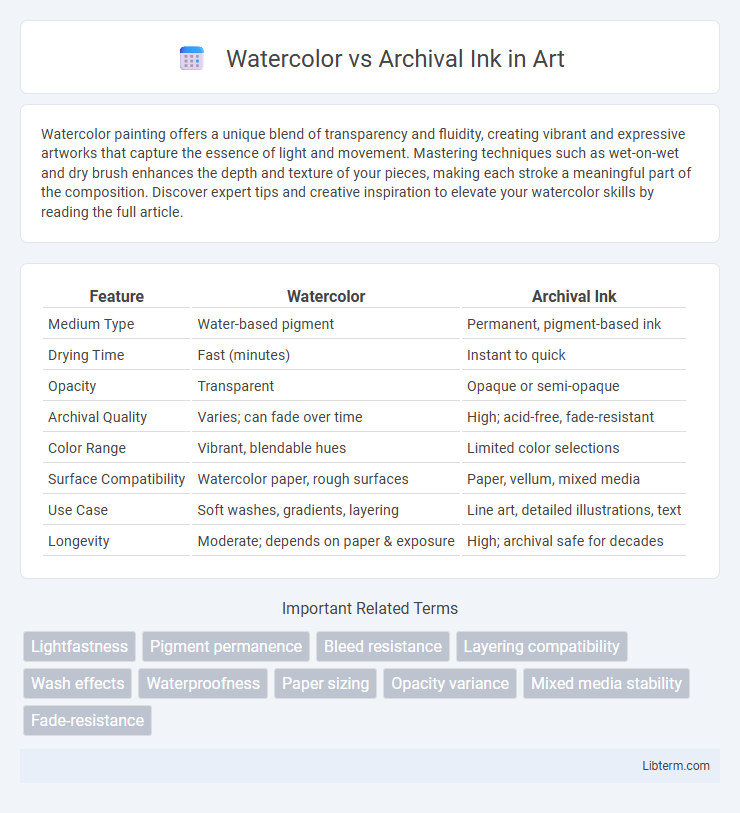Watercolor painting offers a unique blend of transparency and fluidity, creating vibrant and expressive artworks that capture the essence of light and movement. Mastering techniques such as wet-on-wet and dry brush enhances the depth and texture of your pieces, making each stroke a meaningful part of the composition. Discover expert tips and creative inspiration to elevate your watercolor skills by reading the full article.
Table of Comparison
| Feature | Watercolor | Archival Ink |
|---|---|---|
| Medium Type | Water-based pigment | Permanent, pigment-based ink |
| Drying Time | Fast (minutes) | Instant to quick |
| Opacity | Transparent | Opaque or semi-opaque |
| Archival Quality | Varies; can fade over time | High; acid-free, fade-resistant |
| Color Range | Vibrant, blendable hues | Limited color selections |
| Surface Compatibility | Watercolor paper, rough surfaces | Paper, vellum, mixed media |
| Use Case | Soft washes, gradients, layering | Line art, detailed illustrations, text |
| Longevity | Moderate; depends on paper & exposure | High; archival safe for decades |
Introduction to Watercolor and Archival Ink
Watercolor is a transparent pigment mixed with water, valued for its vibrant hues and ability to create soft washes and subtle gradients. Archival ink refers to permanent, fade-resistant ink formulated to maintain its color and integrity over time, commonly used in fine art and documentation. Understanding the properties and applications of both materials is essential for artists aiming for longevity and visual impact in their work.
Key Characteristics of Watercolor
Watercolor paint features transparency and fluidity, allowing for smooth blending and subtle layering effects that create luminous washes. It is composed of pigment suspended in a water-soluble binder, typically gum arabic, which facilitates reactivation with water after drying. Watercolors are prized for their versatility in creating gradients, soft edges, and delicate details that enhance artistic expression.
Defining Features of Archival Ink
Archival ink is characterized by its waterproof, fade-resistant, and acid-free properties, ensuring longevity and durability on various paper types. Unlike watercolor, which is translucent and water-soluble, archival ink produces sharp, permanent lines that resist smudging and deterioration over time. Its quick-drying formula and resistance to UV light make it ideal for preserving artwork, documents, and calligraphy with lasting clarity.
Color Vibrancy and Longevity Comparison
Watercolor pigments offer vibrant, translucent colors that can shift in intensity depending on dilution and paper texture, but they are susceptible to fading over time without proper archival treatment. Archival ink provides consistent, rich color intensity with excellent resistance to fading, ensuring long-term preservation of artwork or documents. For longevity and sustained vibrancy, archival ink outperforms watercolor pigments, especially when exposure to light and environmental factors is a concern.
Surface Compatibility and Paper Choices
Watercolor paints excel on absorbent surfaces such as cold-pressed or rough watercolor paper that allows pigment to spread and blend seamlessly. Archival ink requires smooth, non-porous surfaces like hot-pressed paper or specialized Bristol board to prevent feathering and ensure long-lasting, crisp lines. Selecting the right paper specifically designed for watercolor or archival ink is crucial to achieve optimal texture, durability, and color vibrancy.
Techniques Unique to Watercolor
Watercolor techniques emphasize transparency, layering, and fluid blending, allowing vibrant washes and subtle gradients unique to the medium. Techniques such as wet-on-wet enable the colors to bleed organically, producing soft edges and natural textures that are difficult to replicate with archival ink. Additionally, watercolor's rewettable properties allow artists to lift or modify pigments, enhancing depth and light effects unattainable through permanent archival ink applications.
Techniques Unique to Archival Ink
Archival ink offers unparalleled durability and precision, making it ideal for intricate line work and fine details that resist fading and smudging over time. Techniques unique to archival ink include layering transparent washes without compromising clarity, enabling artists to build depth while maintaining crisp edges. Unlike watercolor, archival ink allows for permanent mark-making that can withstand environmental factors, perfect for detailed illustrations and mixed media artworks requiring longevity.
Combining Watercolor and Archival Ink
Combining watercolor and archival ink enhances artwork by merging vibrant, translucent washes with precise, permanent lines that resist fading and smudging over time. Archival ink, typically pigment-based, preserves fine details and contrast on watercolor paper, ensuring longevity and water resistance after drying. This technique is ideal for mixed-media artists seeking durable, expressive compositions with both fluid color gradients and sharp ink work.
Best Uses for Each Medium
Watercolor excels in creating vibrant washes, gradients, and subtle color variations ideal for landscapes and portraits, benefiting artists seeking fluidity and transparency. Archival ink offers permanence and sharp detail, perfect for technical drawings, calligraphy, and mixed-media projects requiring longevity and resistance to fading. Choosing between them depends on whether the artwork prioritizes expressive color blending or precise, durable lines.
Choosing the Right Medium for Your Artwork
Watercolor offers vibrant, translucent layers that blend seamlessly on paper, ideal for fluid, expressive art styles, while archival ink provides precise, permanent lines resistant to fading and smudging, perfect for detailed illustrations and mixed media projects. Selecting the right medium depends on the desired durability, texture, and visual effect, with archival ink ensuring longevity due to its fade-proof, acid-free properties. Understanding the strengths of each medium enables artists to create artwork that aligns with their aesthetic vision and archival requirements.
Watercolor Infographic

 libterm.com
libterm.com